InSight
  Top: Artist's rendering of the MarCO CubeSats Bottom: Artist's rendering of the InSight lander | |||||||||||
| Names |
Interior Exploration using Seismic Investigations, Geodesy and Heat Transport Geophysical Monitoring Station Discovery 12 | ||||||||||
|---|---|---|---|---|---|---|---|---|---|---|---|
| Mission type | Mars lander | ||||||||||
| Operator | NASA / JPL | ||||||||||
| COSPAR ID | 2018-042A | ||||||||||
| SATCAT no. | 43457 | ||||||||||
| Website |
mars | ||||||||||
| Mission duration |
Planned: 2 years on Mars[1] Elapsed: 5 months, 13 days | ||||||||||
| Spacecraft properties | |||||||||||
| Manufacturer | Lockheed Martin Space Systems | ||||||||||
| Launch mass | 694 kg (1,530 lb)[2] | ||||||||||
| Landing mass | 358 kg (789 lb)[2] | ||||||||||
| Dimensions | Deployed: 6.0 × 1.56 × 1.0 m (19.7 × 5.1 × 3.3 ft)[3] | ||||||||||
| Power | 600 W, solar / Li-ion battery[2] | ||||||||||
| Start of mission | |||||||||||
| Launch date | 5 May 2018, 11:05 UTC[4][5] | ||||||||||
| Rocket | Atlas V 401[6] | ||||||||||
| Launch site | Vandenberg SLC-3E[6] | ||||||||||
| Contractor | United Launch Alliance | ||||||||||
| Mars lander | |||||||||||
| Landing date | 26 November 2018 (planned)[7] | ||||||||||
| Landing site |
Elysium Planitia[8][9] 4°30′N 135°00′E / 4.5°N 135.0°E | ||||||||||
| Flyby of Mars | |||||||||||
| Spacecraft component | MarCO | ||||||||||
| Closest approach | 26 November 2018 (planned) | ||||||||||
| |||||||||||
|
| |||||||||||
InSight is a robotic lander designed to study the interior of the planet Mars.[10][11] The mission launched on 5 May 2018 at 11:05 UTC[12] and is expected to land on the surface of Mars at Elysium Planitia on 26 November 2018,[4][13] where it will deploy a seismometer and burrow a heat probe. It will also perform a radio science experiment to study the internal structure of Mars.[14]
The mission is managed by the Jet Propulsion Laboratory for NASA. The lander was manufactured by Lockheed Martin Space Systems and was originally planned for launch in March 2016.[11][15] Due to the failure of its SEIS instrument prior to launch, NASA announced in December 2015 that the mission had been postponed, and in March 2016, the launch was rescheduled for 5 May 2018, when it launched successfully. The name is a backronym for Interior Exploration using Seismic Investigations, Geodesy and Heat Transport.[1]
InSight's objective is to place a stationary lander equipped with a seismometer called SEIS produced by the French space agency CNES, and heat transfer a heat probe called HP3 produced by the German space agency DLR on the surface of Mars to study the planet's early geological evolution. This could bring new understanding of the Solar System's terrestrial planets — Mercury, Venus, Earth, Mars — and the Earth's Moon. By reusing technology from the Mars Phoenix lander, which successfully landed on Mars in 2008, it is expected that the cost and risk will be reduced.[1]
Following a persistent vacuum failure in the SEIS scientific instrument, the launch window was missed, and the InSight spacecraft was returned to Lockheed Martin's facility in Denver, Colorado, for storage. NASA officials decided in March 2016 to spend an estimated US$150 million to delay launching InSight to May 2018.[5] This would allow time for the seismometer issue to be fixed, although it increased the cost from the previous US$675 million to a total of $830 million.[16]
History and background

InSight was initially known as GEMS (Geophysical Monitoring Station), but its name was changed in early 2012 following a request by NASA.[17] Out of 28 proposals from 2010,[18] it was one of the three Discovery Program finalists receiving US$3 million in May 2011 to develop a detailed concept study.[19] In August 2012, InSight was selected for development and launch.[11] Managed by NASA's Jet Propulsion Laboratory (JPL) with participation from scientists from several countries, the mission is cost-capped at US$425 million, not including launch vehicle funding.[20]
Lockheed Martin began construction of the lander on 19 May 2014,[21] with general testing starting in 27 May 2015.[22]
A persistent vacuum leak in the CNES-supplied seismometer known as the Seismic Experiment for Interior Structure (SEIS) led NASA to postpone the planned launch in March 2016 to May 2018. NASA's Jet Propulsion Laboratory took over development of the vacuum container for SEIS, with CNES handling instrument integration and test activities.[23] The difficulty of an interplanetary seismometer was experienced by NASA when the Viking 1 lander's seismometer did not deploy properly in 1976.[24] The seismometers on Viking were mounted on the lander, which meant that it also picked up vibrations from various operations of the lander and by the wind.[25] The seismometer readings were used to estimate a Martian geological crust thickness between 14 and 18 km (8.7 and 11.2 mi) at the Viking 2 lander site.[26] The Viking 2 seismometer detected pressure from the Mars winds complementing the meteorology results.[26][27] There was one candidate for a possible Marsquake, although it was not confirmed due to the limitations of the design, especially due to noise from other sources like wind. The wind data did prove useful in its own right, and despite the limitations of the data, widespread and large seismic events could be ruled out (large Marsquakes were not detected).[28]
Seismometers were also left on the Moon by the Apollo 12, 14, 15 and 16 missions and provided many insights into lunar seismology, including the discovery of moonquakes.[29] The Apollo seismic network, which was operated until 1977, detected at least 28 moonquakes up to 5.5 on the richter scale.[30]
Radio Doppler measurements were taken with Viking and twenty years later with Mars Pathfinder, and in each case the axis of rotation of Mars was calculated. By combining this data the core size was constrained, because the change in axis of rotation over 20 years allowed a precession rate and from that the planet's moment of inertia to be calculated.[31]
When InSight was delayed, the rest of the spacecraft was returned to Lockheed Martin's factory in Colorado for storage, and the Atlas V rocket intended to launch the spacecraft was reassigned to the WorldView-4 mission.[32]
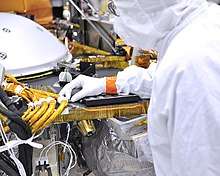
NASA officials announced on 9 March 2016 that InSight would be delayed until the 2018 launch window at an estimated cost of US$150 million.[5][7] The spacecraft was rescheduled to launch on 5 May 2018 for a Mars landing on 26 November; the flight plan remained unchanged with launch using an Atlas V rocket from Vandenberg Air Force Base in California.[5][7] NASA's Jet Propulsion Laboratory was tasked with redesigning and building a new vacuum enclosure for the SEIS instrument, while CNES conducted instrument integration and testing.[23][33]
On 22 November 2017 InSight completed testing in a thermal vacuum, also known as TVAC testing, where the spacecraft is put in simulated space conditions with reduced pressure and various thermal loads.[34] On 23 January 2018 its solar panels were deployed and tested, and a second silicon chip containing 1.6 million names from the public was added to the lander.[35]
On 28 February 2018 InSight was shipped from Lockheed Martin Space Systems in Denver to Vandenberg Air Force Base, California, by a C-17 cargo aircraft to begin final preparations for launch.[36]
Objectives
InSight will place a single stationary lander on Mars to study its deep interior and address a fundamental issue of planetary and Solar System science: understanding the processes that shaped the rocky planets of the inner Solar System (including Earth) more than four billion years ago.[37]
_-_Artist's_Concept.jpg)
InSight's primary objective is to study the earliest evolutionary history of the processes that shaped Mars. By studying the size, thickness, density and overall structure of Mars' core, mantle and crust, as well as the rate at which heat escapes from the planet's interior, InSight will provide a glimpse into the evolutionary processes of all of the rocky planets in the inner Solar System.[38][37] The rocky inner planets share a common ancestry that begins with a process called accretion. As the body increases in size, its interior heats up and evolves to become a terrestrial planet, containing a core, mantle and crust.[39] Despite this common ancestry, each of the terrestrial planets is later shaped and molded through a poorly understood process called differentiation. InSight mission's goal is to improve the understanding of this process and, by extension, terrestrial evolution, by measuring the planetary building blocks shaped by this differentiation: a terrestrial planet's core, mantle and crust.[39]
The mission will determine if there is any seismic activity, measure the amount of heat flow from the interior, estimate the size of Mars' core and whether the core is liquid or solid.[40] This data would be the first of its kind for Mars.[41] It is also expected that frequent meteor airbursts (10–200 detectable events per year for InSight) will provide additional seismo-acoustic signals to probe the interior of Mars.[42] The mission's secondary objective is to conduct an in-depth study of geophysics, tectonic activity and the effect of meteorite impacts on Mars, which could provide knowledge about such processes on Earth. Measurements of crust thickness, mantle viscosity, core radius and density, and seismic activity should result in an accuracy increase of 3× to 10× compared with current data.[41]
In terms of fundamental processes shaping planetary formation, it is thought that Mars contains the most in-depth and accurate historical record, because it is big enough to have undergone the earliest accretion and internal heating processes that shaped the terrestrial planets, but is small enough to have retained signs of those processes.[37]
Design
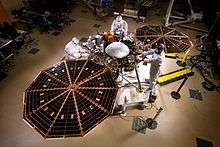
The mission further develops a design inherited from the 2008 Phoenix Mars Lander.[43] Because InSight is powered by solar panels, it will land near the equator to enable maximum power for a projected lifetime of 2 years (1 Martian year).[1] InSight is designed to be launched by an Atlas V rocket; the mission will include two CubeSats that will launch with InSight but will fly separately to Mars.[44]
Lander specifications
- Mass
- Total: 694 kg (1,530 lb)[2]
- Mars Cube One CubeSats: 13.5 kg (30 lb) each[2]
- Dimensions
- About 6.0 m (19.7 ft) wide with solar panels deployed. The science deck is about 1.56 m (5.1 ft) wide and between 0.83 and 1.08 m (2.7 and 3.5 ft) high (depending on leg compression after landing).[2] The length of the robotic arm is 2.4 m (7.9 ft)[2]
- Power
- Power is generated by two round solar panels, each 2.15 m (7.1 ft) in diameter and consisting of SolAero ZTJ triple-junction solar cells made of InGaP/InGaAs/Ge arranged on Orbital ATK UltraFlex arrays. After touchdown on the Martian surface, the arrays are deployed by opening like a folding fan.[45][46]
Payload
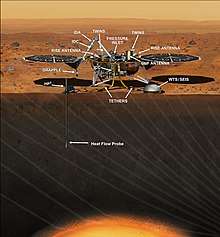
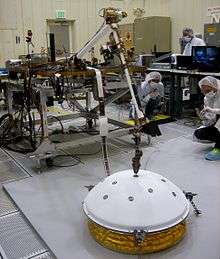
.png)
InSight's payload has a total mass of 50 kg, including science instruments and support systems such as the Auxiliary Payload Sensor Suite, cameras, the instrument deployment system, and a laser retroreflector.[2] The science payload consists of two main instruments, SEIS and HP3:
- The Seismic Experiment for Interior Structure (SEIS) will take precise measurements of quakes and other internal activity on Mars to better understand the planet's history and structure. It will also investigate how the Martian crust and mantle respond to the effects of meteorite impacts, which gives clues to the planet's inner structure.[47][48][49] SEIS was provided by the French Space Agency (CNES), with the participation of the Institut de Physique du Globe de Paris (IPGP), the Swiss Federal Institute of Technology (ETH), the Max Planck Institute for Solar System Research (MPS), Imperial College, Institut supérieur de l'aéronautique et de l'espace (ISAE) and JPL.[50][51] The seismometer will also detect sources including atmospheric waves and gravimetric signals (tidal forces) from Mars' moon Phobos, up to high frequency seismic waves of 50 Hz.[52][53] SEIS was found to have a vacuum leak which could not be corrected in time for the launch of InSight, forcing a two-year mission postponement.[23]
- The SEIS instrument is supported by a suite of meteorological tools to characterize atmospheric disturbances that might affect the experiment. These include a vector magnetometer provided by UCLA that will measure magnetic disturbances such as those caused by the Martian ionosphere; a suite of air temperature, wind speed and wind direction sensors based on the Spanish/Finnish Rover Environmental Monitoring Station; and a barometer from JPL.[54][31]
- The Heat Flow and Physical Properties Package (HP3), provided by the German Aerospace Center (DLR), is a self-penetrating heat flow probe.[53][43][55][56] Referred to as a "self-hammering nail" and nicknamed "the mole", it was designed to burrow as deep as 5 m (16 ft) below the Martian surface while trailing a tether with embedded heat sensors to measure how efficiently heat flows through Mars' core, and thus reveal unique information about the planet's interior and how it has evolved over time.[53][43][55][56] It trails a tether containing precise temperature sensors every 10 cm (3.9 in) to measure the temperature profile of the subsurface.[53][57] The tractor mole of the instrument was provided by the Polish company Astronika.[58]
- The Rotation and Interior Structure Experiment (RISE) led by the Jet Propulsion Laboratory (JPL), will use the lander's X-band radio to provide precise measurements of planetary rotation to better understand the interior of Mars.[59] X-band radio tracking, capable of an accuracy under 2 cm, will build on previous Viking program and Mars Pathfinder data.[53] The previous data allowed the core size to be estimated, but with more data from InSight, the nutation amplitude can be determined.[53] Once spin axis direction, precession, and nutation amplitudes are better understood, it should be possible to calculate the size and density of the Martian core and mantle.[53] This should increase our understanding of the formation of terrestrial planets (e.g. Earth) and rocky exoplanets.[53]
- Temperature and Winds for InSight (TWINS), fabricated by Spain's Centro de Astrobiología, will monitor weather at the landing site.[41][54]
- Laser RetroReflector for InSight (LaRRI) is a corner cube retroreflector provided by the Italian Space Agency and mounted on InSight's top deck.[60][61] It will enable passive laser range-finding by orbiters even after the lander is retired,[62] and would function as a node in a proposed Mars geophysical network.[63] This device previously flew on the Schiaparelli lander as the Instrument for Landing-Roving Laser Retroreflector Investigations (INRRI), and was an aluminum dome 54 mm (2.1 in) in diameter and 25 g (0.9 oz) in mass featuring eight fused silica reflectors.[62]
- Instrument Deployment Arm (IDA) is a 2.4 m robotic arm that will be used to deploy the SEIS and HP3 instruments to Mars' surface.[31]
- The Instrument Deployment Camera (IDC) is a color camera based on the Mars Exploration Rover and Mars Science Laboratory navcam design. It is stationed on the Instrument Deployment Arm and will image the instruments on the lander's deck and provide stereoscopic views of the terrain surrounding the landing site. It features a 45-degree field of view and uses a 1024 × 1024 pixel CCD detector.[64] The IDC sensor was originally black and white; a program was enacted that tested with a standard hazcam and, since development deadlines and budgets were met, was replaced with a color sensor.[65]
- The Instrument Context Camera (ICC) is a color camera based on the MER/MSL hazcam design. It is mounted below the lander's deck, and with its wide-angle 120-degree panoramic field of view will provide a complementary view of the instrument deployment area. Like the IDC, it uses a 1024 × 1024 pixel CCD detector.[64]

Launch
.jpg)
| Wikinews has related news: NASA's InSight lander and MarCO craft launch in new mission to Mars |
The spacecraft was launched on 5 May 2018 at 11:05 UTC on an Atlas V 401 launch vehicle (AV-078) from Vandenberg Air Force Base Space Launch Complex 3-East.[66] This was the first American interplanetary mission to launch from California.[67]
The launch was managed by NASA's Launch Services Program. InSight was originally scheduled for launch on 4 March 2016 on an Atlas V 401 (4 meter fairing/zero (0) solid rocket boosters/single (1) engine Centaur) from Vandenberg Air Force Base in California, U.S.,[67] but was called off in December 2015 due to a vacuum leak on the SEIS instrument.[68][69][70] The rescheduled launch window ran from 5 May to 8 June 2018.
The journey to Mars will take 6.5 months across 484 million km (301 million mi) for a touchdown expected on 26 November.[4][13] If it lands successfully, a two-month-long deployment phase would commence as part of its two-year (about one Martian year) prime mission.[61][13]
Planned landing site

As InSight's science goals are not related to any particular surface feature of Mars, potential landing sites were chosen on the basis of practicality. Candidate sites needed to be near the equator of Mars to provide sufficient sunlight for the solar panels year round, have a low elevation to allow for sufficient atmospheric braking during EDL, flat, relatively rock-free to reduce the probability of complications during landing, and soft enough terrain to allow the heat flow probe to penetrate well into the ground. An optimal area that meets all these requirements is Elysium Planitia, so all 22 initial potential landing sites were located in this area.[71] The only two other areas on the equator and at low elevation, Isidis Planitia and Valles Marineris, are too rocky. In addition, Valles Marineris has too steep a gradient to allow safe landing.[8]
In September 2013, the initial 22 potential landing sites were narrowed down to 4, and the Mars Reconnaissance Orbiter was then used to gain more information on each of the 4 potential sites before a final decision was made.[8][72] Each site consists of a landing ellipse that measures about 130 by 27 km (81 by 17 mi).[73] In March 2017, scientists from the Jet Propulsion Laboratory announced that the landing site had been selected. It is located in western Elysium Planitia at 4°30′N 135°54′E / 4.5°N 135.9°E.[74] The landing site is about 600 km (370 mi) from where the Curiosity rover is operating in Gale Crater.[75]
Team and participation
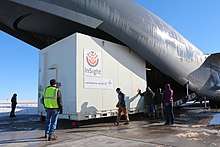
The InSight science and engineering team includes scientists and engineers from many disciplines, countries and organizations. The science team assigned to InSight includes scientists from institutions in the U.S., France, Germany, Austria, Belgium, Canada, Japan, Switzerland, Spain and the United Kingdom.[76]
Mars Exploration Rover project scientist W. Bruce Banerdt is the principal investigator for the InSight mission and the lead scientist for the SEIS instrument.[77] Suzanne Smrekar, whose research focuses on the thermal evolution of planets and who has done extensive testing and development on instruments designed to measure the thermal properties and heat flow on other planets,[78] is the lead for InSight's HP3 instrument. Sami Asmar, an expert in advanced studies using radio waves,[79] is the lead for InSight's RISE investigation. The InSight mission team also includes project manager Tom Hoffman and deputy project manager Henry Stone.[76]
Major contributing agencies and institutions:[61]
National agencies:
- National Aeronautics and Space Administration (NASA)
- Centre National d'Études Spatiales (CNES)
- Deutsches Zentrum für Luft- und Raumfahrt (DLR)
Contributing institutions:
- Jet Propulsion Laboratory (NASA/JPL)
- Lockheed Martin
- Institut de Physique du Globe de Paris (IPGP)
- Swiss Federal Institute of Technology in Zurich (ETHZ)
- Max Planck Institute for Solar System Research (MPS)
- Imperial College London
- Institut supérieur de l'aéronautique et de l'espace (ISAE-SUPAERO)
- University of Oxford
- Centro de Astrobiología (CAB)
- Centrum Badan Kosmicznych (CBK)
Name chips
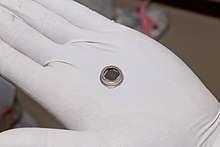
As part of its public outreach, NASA organized a program where members of the public were able to have their names sent to Mars aboard InSight. Due to its launch delay, two rounds of sign-ups were conducted totaling 2.4 million names:[80][81] 826,923 names were registered in 2015[82] and a further 1.6 million names were added in 2017.[83] An electron beam was used to etch letters only 1⁄1000 the width of a human hair onto 8 mm (0.3 in) silicon wafers.[82] The first chip was installed on the lander in November 2015 and the second on 23 January 2018.[82][83]
CubeSats
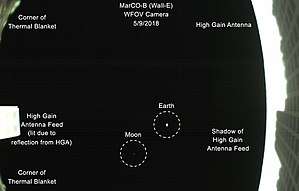
The Mars Cube One (MarCO) spacecraft are a pair of 6U CubeSats that piggybacked with the InSight mission to test CubeSat navigation and endurance in deep space, and to help relay real-time communications during the probe's entry, descent and landing (EDL) phase.[84][85] The two 6U CubeSats, named "MarCO" A and B, are identical.[86] They measure 30 cm × 20 cm × 10 cm (11.8 in × 7.9 in × 3.9 in) and are flying as a pair for redundancy. They will not enter orbit but fly past Mars during the EDL phase of the mission and relay InSight's telemetry in real time.[87][88] MarCO is a technology capability demonstration of a communications relay system.
The Atlas V Booster launched the MarCO CubeSats together with the InSight cruise stage; afterwards, the two CubeSats separated from the cruise stage after launch and are flying their own trajectory to Mars.[44] This is notably different from the twin Deep Space 2 probes, which were attached to the Mars Polar Lander cruise stage on its way to Mars. Near Mars, the Deep Space 2 probes separated for their mini-mission, but they were never heard from, and Mars Polar Lander was lost on landing (Mars Global Surveyor was in orbit for communication at that time).
Mars map
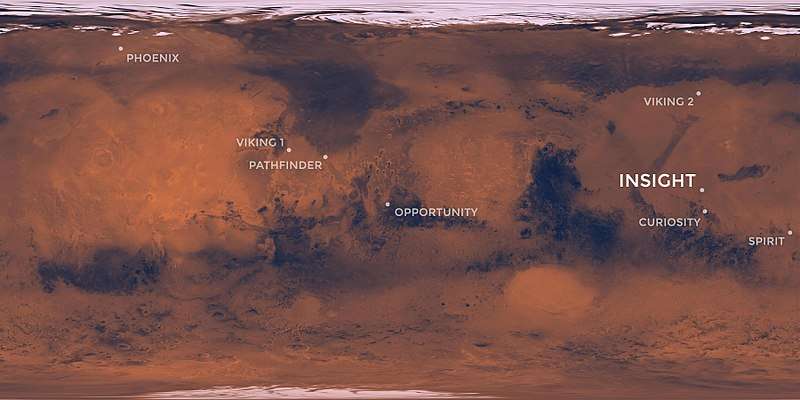
See also
References
- 1 2 3 4 "InSight – Mission Overview". NASA. 2012. Retrieved 22 August 2012.
- 1 2 3 4 5 6 7 8 9 10 11 12 "Mars InSight Launch Press Kit" (PDF). NASA/JPL. May 2018. Retrieved 26 May 2018.
- ↑ "InSight Lithograph" (PDF). NASA. July 2015. LG-2015-07-072-HQ.
- 1 2 3 Chang, Kenneth (5 May 2018). "NASA's InSight Launches for Six-Month Journey to Mars". The New York Times. Retrieved 5 May 2018.
- 1 2 3 4 Clark, Stephen (9 March 2016). "InSight Mars lander escapes cancellation, aims for 2018 launch". Spaceflight Now. Retrieved 9 March 2016.
- 1 2 Clark, Stephen (19 December 2013). "Mars lander to launch from California on Atlas 5 in 2016". Spaceflight Now. Retrieved 20 December 2013.
- 1 2 3 Chang, Kenneth (9 March 2016). "NASA Reschedules Mars InSight Mission for May 2018". The New York Times. Retrieved 9 March 2016.
- 1 2 3 "NASA Evaluates Four Candidate Sites for 2016 Mars Mission". NASA. 4 September 2013. Retrieved 4 September 2013.
- ↑ "Single Site on Mars Advanced for 2016 NASA Lander". NASA. 4 March 2015. Retrieved 16 December 2015.
- ↑ Chang, Kenneth (30 April 2018). "Mars InSight: NASA's Journey Into the Red Planet's Deepest Mysteries". The New York Times. Retrieved 30 April 2018.
- 1 2 3 Vastag, Brian (20 August 2012). "NASA will send robot drill to Mars in 2016". The Washington Post.
- ↑ Agle, D.C.; Good, Andrew; Brown, Dwayne; Wendel, JoAnna (5 May 2018). "NASA, ULA Launch Mission to Study How Mars Was Made". Retrieved 5 May 2018.
- 1 2 3 "About InSight's Launch". NASA. Retrieved 8 February 2018.
- ↑ "What are InSight's Science Tools?". NASA. Retrieved 8 February 2018.
- ↑ David, Leonard (14 November 2017). "NASA's Next Mars Lander Zooms toward Launch". Scientific American. Archived from the original on 14 November 2017.
- ↑ Webster, Guy; Brown, Dwayne; Cantillo, Laurie (2 September 2016). "NASA Approves 2018 Launch of Mars InSight Mission". NASA. Retrieved 8 January 2018.
- ↑ Wells, Jason (28 February 2012). "JPL changes name of Mars mission proposal". Times Community News via Los Angeles Times. Retrieved 25 September 2016.
- ↑ "New NASA Mission To take First Look Deep Inside Mars". NASA. 20 August 2012.
- ↑ "NASA Selects Investigations For Future Key Planetary Mission". NASA. 5 May 2011. Retrieved 6 May 2011.
- ↑ Taylor, Kate (9 May 2011). "NASA picks project shortlist for next Discovery mission". TG Daily. Retrieved 20 May 2011.
- ↑ Webster, Guy; Brown, Dwayne; Napier, Gary (19 May 2014). "Construction to Begin on 2016 NASA Mars Lander". NASA. Retrieved 20 May 2014.
- ↑ Webster, Guy; Brown, Dwayne (27 May 2015). "NASA Begins Testing Mars Lander for Next Mission to Red Planet". NASA. Retrieved 28 May 2015.
- 1 2 3 Foust, Jeff (28 March 2016). "InSight's second chance". The Space Review. Retrieved 5 April 2016.
- ↑ "Happy Anniversary, Viking Lander". Science@NASA. NASA. 20 July 2001.
- ↑ Anderson, Don L.; et al. (September 1977). "Signatures of Internally Generated Lander Vibrations" (PDF). Journal of Geophysical Research. 82 (28): 4524–4546, A-2. Bibcode:1977JGR....82.4524A. doi:10.1029/JS082i028p04524.
- 1 2 Howell, Elizabeth (6 December 2012). "Viking 2: Second Landing on Mars". Space.com. Retrieved 15 November 2017.
- ↑ Nakamura, Y.; Anderson, D. L. (June 1979). "Martian wind activity detected by a seismometer at Viking lander 2 site". Geophysical Research Letters. 6: 499–502. Bibcode:1979GeoRL...6..499N. doi:10.1029/GL006i006p00499.
- ↑ Lorenz, Ralph D.; Nakamura, Yosio; Murphy, James R. (November 2017). "Viking-2 Seismometer Measurements on Mars: PDS Data Archive and Meteorological Applications". Earth and Space Science. 4 (11): 681–688. Bibcode:2017E&SS....4..681L. doi:10.1002/2017EA000306.
- ↑ Goins, N. R.; et al. (June 1981). "Lunar seismology – The internal structure of the moon". Journal of Geophysical Research. 86: 5061–5074. Bibcode:1981JGR....86.5061G. doi:10.1029/JB086iB06p05061.
- ↑ Bell, Trudy E. (15 March 2006). "Moonquakes". Science@NASA. NASA Science Mission Directorate. Retrieved 31 January 2018.
- 1 2 3 Banerdt, W. Bruce (7 March 2013). InSight: A Geophysical Mission to a Terrestrial Planet Interior (PDF). Committee on Astrobiology and Planetary Science. 6–8 March 2013. Washington, D.C.
- ↑ Clark, Stephen (5 March 2016). "Fate of NASA's InSight Mars mission to be decided soon". Spaceflight Now. Retrieved 9 March 2016.
- ↑ "NASA Targets May 2018 Launch of Mars InSight Mission". NASA. 9 March 2016. Retrieved 9 March 2016.
- ↑ Bergin, Chris (22 November 2017). "Mars InSight mission passes TVAC testing ahead of 2018 launch". NASASpaceFlight.com. Retrieved 6 January 2018.
- ↑ Good, Andrew (23 January 2018). "NASA's Next Mars Lander Spreads its Solar Wings". NASA.
- ↑ "NASA InSight Mission to Mars Arrives at Launch Site". NASA. 28 February 2018. Retrieved 5 March 2018.
- 1 2 3 "InSight: Mission". NASA/Jet Propulsion Laboratory. Retrieved 2 December 2011.
- ↑ Panning, Mark; Lognonne, Philippe; Banerdt, Bruce; et al. (October 2017). "Planned Products of the Mars Structure Service for the InSight Mission to Mars". Space Science Reviews. 211 (1–4): 611-650. doi:10.1007/s11214-016-0317-5.
- 1 2 "InSight: Science". NASA/Jet Propulsion Laboratory. Retrieved 2 December 2011.
- ↑ Kremer, Ken (2 March 2012). "NASAs Proposed 'InSight' Lander would Peer to the Center of Mars in 2016". Universe Today. Retrieved 27 March 2012.
- 1 2 3 Banerdt, W. Bruce (2013). InSight Project Status (PDF). 28th Mars Exploration Program Analysis Group Meeting. 23 July 2013. Virtual meeting.
- ↑ Stevanović, J.; et al. (October 2017). "Bolide Airbursts as a Seismic Source for the 2018 Mars InSight Mission". Space Science Reviews. 211 (1–4): 525–545. Bibcode:2017SSRv..211..525S. doi:10.1007/s11214-016-0327-3.
- 1 2 3 Agle, D. C. (20 August 2012). "New Insight on Mars Expected From new NASA Mission". NASA.
- 1 2 "Mars Cube One (MarCO)". NASA. Retrieved 8 February 2018.
- ↑ "SolAero Awarded Solar Panel Manufacturing Contract by ATK for NASA's InSight Mars Lander Mission" (Press release). SolAero. 26 February 2014. Retrieved 13 June 2015.
- ↑ "UltraFlex Solar Array Systems" (PDF). Orbital ATK. Retrieved 13 June 2015.
- ↑ "NASA and French Space Agency Sign Agreement for Mars Mission" (Press release). NASA. 10 February 2014. Retrieved 11 February 2014.
- ↑ Boyle, Rebecca (4 June 2015). "Listening to meteorites hitting Mars will tell us what's inside". New Scientist. Retrieved 5 June 2015.
- ↑ Kumar, Sunil (1 September 2006). Design and development of a silicon micro-seismometer (PDF) (Ph.D.). Imperial College London. Retrieved 15 July 2015.
- ↑ Francis, Matthew (21 August 2012). "New probe to provide InSight into Mars' interior". Ars Technica. Retrieved 21 August 2012.
- ↑ Lognonné, P.; Banerdt, W. B.; Giardini, D.; Christensen, U.; Pike, T.; et al. (October 2011). The GEMS (GEophysical Monitoring Station) SEISmometer (PDF). EPSC-DPS Joint Meeting 2011. 2–7 October 2011. Nantes, France. Bibcode:2011epsc.conf.1507L. EPSC-DPS2011-1507-1.
- ↑ Panning, Mark P.; et al. (October 2017). "Planned Products of the Mars Structure Service for the InSight Mission to Mars" (PDF). Space Science Reviews. 211 (1–4): 611–650. Bibcode:2017SSRv..211..611P. doi:10.1007/s11214-016-0317-5.
- 1 2 3 4 5 6 7 8 Banerdt, W. Bruce (2012). InSight – Geophysical Mission to Mars (PDF). 26th Mars Exploration Program Analysis Group Meeting. 4 October 2012. Monrovia, California.
- 1 2 David, Leonard (15 August 2014). "NASA's Next Mars Lander Will Peer Deep Into Red Planet's History: Here's How". Space.com. Retrieved 16 August 2014.
- 1 2 Grott, M.; Spohn, T.; Banerdt, W. B.; Smrekar, S.; Hudson, T. L.; et al. (October 2011). Measuring Heat Flow on Mars: The Heat Flow and Physical Properties Package on GEMS (PDF). EPSC-DPS Joint Meeting 2011. 2–7 October 2011. Nantes, France. Bibcode:2011epsc.conf..379G. EPSC-DPS2011-379-1.
- 1 2 Kelly, Tiffany (22 May 2013). "JPL begins work on two new missions to Mars". Glendale News-Press. Retrieved 24 August 2015.
- ↑ "HP3 (Heat Flow and Physical Properties Probe)". NASA. Retrieved 24 August 2015.
- ↑ "Polish Kret will fly to Mars". Science in Poland. Retrieved 2018-05-05.
- ↑ Dehant, V.; Folkner, W.; Le Maistre, S.; Rosenblatt, P.; Yseboodt, M.; et al. (October 2011). Geodesy on GEMS (GEophysical Monitoring Station) (PDF). EPSC-DPS Joint Meeting 2011. 2–7 October 2011. Nantes, France. Bibcode:2011epsc.conf.1551D. EPSC-DPS2011-1551.
- ↑ Dell'Agnello, S.; et al. (October 2017). Lunar, Cislunar, Near/Farside Laser Retroreflectors for the Accurate: Positioning of Landers/Rovers/Hoppers/Orbiters, Commercial Georeferencing, Test of Relativistic Gravity, and Metrics of the Lunar Interior (PDF). 2017 Annual Meeting of the Lunar Exploration Analysis Group. 10–12 October 2017. Columbia, Maryland. Bibcode:2017LPICo2041.5070D. Contribution NO. 2041.
- 1 2 3 Banerdt, W. Bruce (6 October 2016). InSight Status Report (PDF). 32nd Mars Exploration Program Analysis Group Meeting. 6 October 2016. Virtual.
- 1 2 "Schiaparelli science package and science investigations". European Space Agency. 19 October 2016.
- ↑ Dell'Agnello, S. (2016). MoonLIGHT and INRRI: Status and Prospects. CSN2 Space Meeting. 20 July 2016. INFN-LNGS, Italy. Istituto Nazionale de Fisica Nucleare.
- 1 2 "Cameras". InSight. NASA. Retrieved 8 February 2018.
- ↑ Golombek, Matt; Banerdt, W. Bruce (2014). InSight Project Status and Landing Site Selection (PDF). 29th Mars Exploration Program Analysis Group Meeting. 13–14 May 2014. Crystal City, Virginia.
- ↑ "Launch Schedule". Spaceflight Now. 6 January 2018. Archived from the original on 8 January 2018.
- 1 2 "NASA Awards Launch Services Contract for InSight Mission". NASA. 19 December 2013. Retrieved 11 January 2014.
- ↑ "NASA calls off next Mars mission because of instrument leak". Excite News. Associated Press. 22 December 2015. Retrieved 22 December 2015.
- ↑ Chang, Kenneth (22 December 2015). "Leaks in Instrument Force NASA to Delay Mars Mission Until 2018". The New York Times. Retrieved 22 December 2015.
- ↑ Brown, Dwayne; Cantillo, Laurie; Webster, Guy; Watelet, Julien (22 December 2015). "NASA Suspends 2016 Launch of InSight Mission to Mars". NASA. Retrieved 23 December 2015.
- ↑ Vergano, Dan (4 September 2013). "NASA searches for (literally) boring Mars landing site". USA Today. Retrieved 5 September 2013.
- ↑ Boyle, Alan (5 March 2015). "NASA Picks Prime Target for 2016 InSight Mars Lander". NBC News. Retrieved 5 March 2015.
- ↑ Wall, Mike (11 March 2015). "NASA Eyeing Landing Site for 2016 Mars Mission". Space.com. Retrieved 11 March 2015.
- ↑ Golombek, M.; et al. (2017). Selection of the 2018 Insight Landing Site. 48th Lunar and Planetary Science Conference. 20–24 March 2017. The Woodlands, Texas. Bibcode:2017LPI....48.1515G. LPI Contribution No. 1964, id.1515.
- ↑ "InSight's Landing Site: Elysium Planitia". NASA. 25 January 2018. Retrieved 1 February 2018.
- 1 2 "InSight: People". NASA/Jet Propulsion Laboratory. Retrieved 2 December 2011.
- ↑ "JPL Science: People – Bruce Banerdt". NASA/Jet Propulsion Laboratory. Retrieved 2 December 2011.
- ↑ "JPL Sciences: People – Sue Smrekar". NASA/Jet Propulsion Laboratory. Retrieved 2 December 2011.
- ↑ "JPL Science and Technology: Sami Asmar". NASA/Jet Propulsion Laboratory. Archived from the original on 15 April 2012.
- ↑ Szondy, David (6 November 2017). "NASA probe to carry over 2.4 million names to Mars". New Atlas. Retrieved 8 January 2018.
- ↑ Santiago, Cassandra; Ahmed, Saeed (1 November 2017). "Today's the last day to get your boarding pass to Mars". CNN. Retrieved 8 January 2018.
- 1 2 3 "Names Chip Placed on InSight Lander Deck". NASA/Jet Propulsion Laboratory. 17 December 2015. Retrieved 4 March 2018.
- 1 2 "Second Names Chip is Placed on InSight". NASA/Jet Propulsion Laboratory. 24 January 2018. Retrieved 4 March 2018.
- ↑ Wall, Mike (12 May 2015). "NASA Wants New Rocket Rides for Tiny CubeSats". Space.com. Retrieved 13 May 2015.
- ↑ Dean, James (16 May 2015). "NASA seeks launchers for smallest satellites". Florida Today. Retrieved 16 May 2015.
- ↑ Schulze-Makuch, Dirk (9 June 2015). "CubeSats to the Rescue?". Smithsonian Air & Space. Retrieved 9 June 2015.
- ↑ Messier, Douglas (27 May 2015). "Two Tiny 'CubeSats' Will Watch 2016 Mars Landing". Space.com. Retrieved 27 May 2015.
- ↑ Asmar, Sami; Matousek, Steve (20 November 2014). Mars Cube One (MarCO) – The First Planetary CubeSat Mission (PDF). NASA/Jet Propulsion Laboratory. Retrieved 27 May 2015.
External links
| Wikimedia Commons has media related to InSight. |
.png)




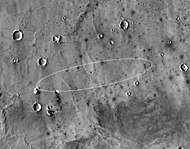
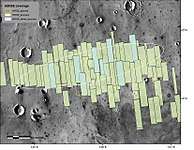
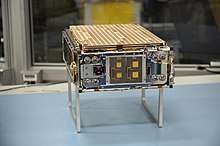
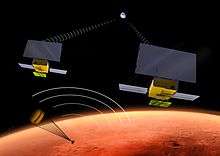
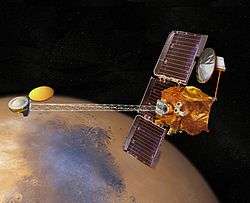
.jpg)
.jpg)
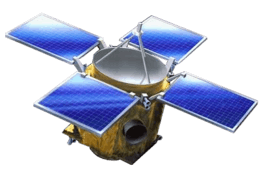
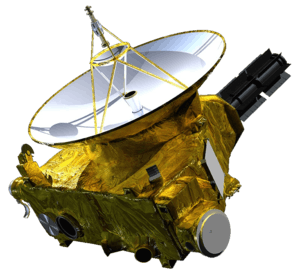

.png)